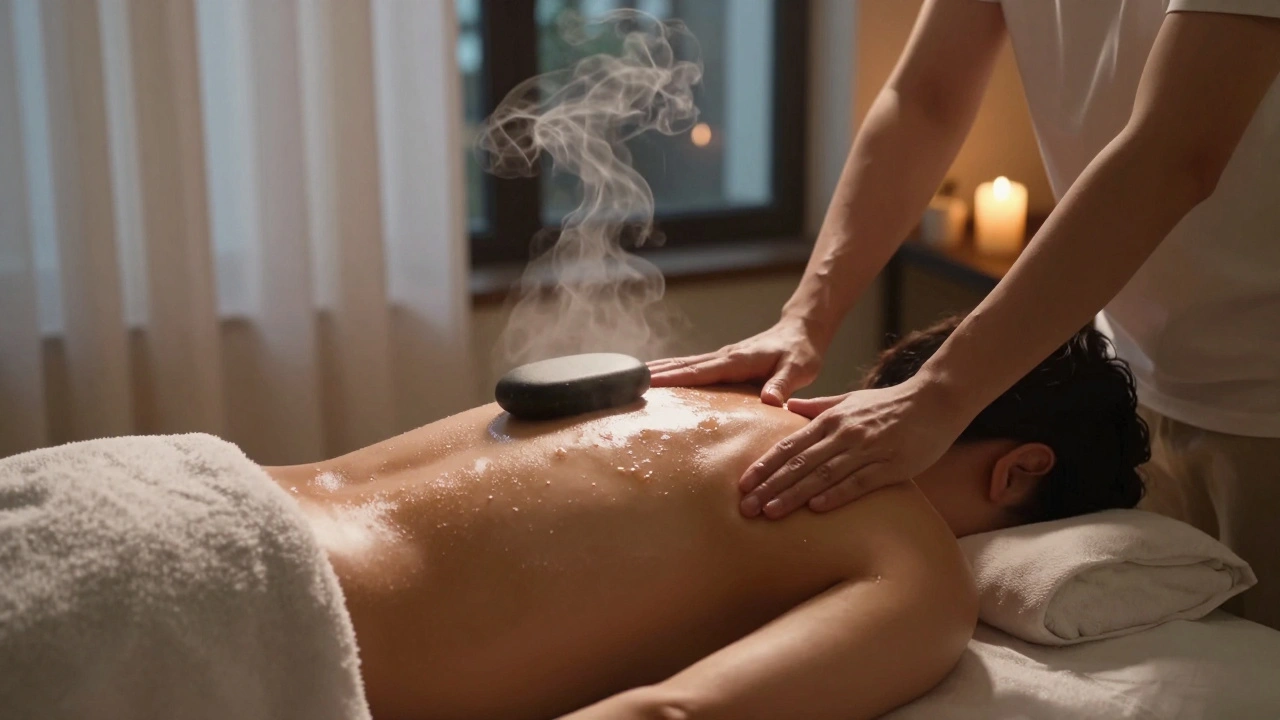Body massage isn't just for sore muscles-it's a proven way to clear mental fog, reduce stress, and improve focus. Discover how regular sessions can reset your mind and boost clarity in just 60 minutes.

- Created by: Archer Caldwell
- Completed on: 9 Jun 2025
- Categories: Body Massage
If your shoulders are turning into rocks or you feel like your mind just won’t quit, you’re not alone. Stress and anxiety are sneaky—they show up in your back, your mood, even your sleep. Here’s some good news: body massage isn’t just a luxury or something reserved for spa days. It’s actually a science-backed way to ease tension and calm your nerves.
Plenty of folks notice they sleep better and feel lighter right after a session. A pro massage therapist knows how to target knots and soothe your nervous system so you really feel the difference. Think of it as a reset button for your body and mind—way better than scrolling on your phone or chugging another coffee.
You don’t need a medical degree to see the difference. After just one hour on the table, people often say their chest feels less tight and their thoughts finally slow down. The real magic? You get some time to yourself, away from constant notifications and daily stress. That’s something most people hardly ever treat themselves to these days.
- Quick Facts & Direct Answers
- What Is Body Massage and Why Should You Care?
- How Body Massage Tackles Stress and Anxiety
- Finding and Choosing the Right Massage for You
Quick Facts & Direct Answers
Here’s the lowdown: if you’re feeling overwhelmed, booking a body massage can genuinely help with stress and anxiety. Don’t just take my word for it—real research backs this up. The American Massage Therapy Association reports that nearly 90% of people say massage reduces their stress. Not bad for something that also feels amazing in the moment.
- Most people start feeling more relaxed within the first few minutes of the massage.
- A regular massage (think once or twice a month) can keep anxiety in check for a lot of folks.
- You don’t need doctor’s orders—anyone can book a session.
- Popular styles for stress relief: Swedish, deep tissue, and aromatherapy massage.
- No fancy gear or prep is needed—just comfy clothes and an open mind.
Want solid proof it works? Check out these numbers from real studies:
| Benefit | Average Reduction (%) | Notes |
|---|---|---|
| Reported Anxiety | 35–40% | After 4-6 weekly sessions |
| Stress Hormone (Cortisol) Levels | Up to 30% | After single session |
| Muscle Tension | 50%+ | Noticeable after one session |
If you just want to know if body massage can help you chill out: yep, it works and the science agrees. Even a 30-minute session can make a difference, but most people go for an hour since it’s more effective. The best part? You walk out feeling more grounded, usually carrying less of that nervous energy that messes with your focus and your mood.
What Is Body Massage and Why Should You Care?
Think of body massage as a hands-on way to reset your body. A trained massage therapist works out tight muscles using specific strokes and pressure. This isn’t just about feeling good while you’re on the table—there’s actual science behind it. When you get a massage, your body kicks up production of feel-good chemicals like serotonin and endorphins while lowering stress hormones such as cortisol. That combo right there is why so many people walk out of a session feeling lighter and less frazzled.
Body massage isn’t just for athletes or people with back pain. It’s for anyone who deals with the stress and hustle of life (so pretty much all of us). Regular sessions can cut that wound-up feeling, help you sleep better, even boost your mood if you’re dealing with anxiety. Plus, you don’t need to do anything during the session except lie there and let the therapist do their thing. Easy win, right?
- Body massage can help manage tension headaches, stiffness, and even digestive trouble caused by stress.
- Some styles, like Swedish or deep tissue, focus on muscles and joints. Others, like aromatherapy massage, combine touch with calming scents.
- You can find sessions lasting anywhere from 30 minutes to two hours, so it can fit into a lunch break or take up an entire afternoon if you want.
It’s not just hype—check out these stats from the American Massage Therapy Association (AMTA):
| Fact | Number/Percent |
|---|---|
| People who get massages for health reasons | 78% |
| Reported reduction in stress after massage | 85% |
| Lowered anxiety after regular monthly sessions | Up to 50% |
The real question is—why wouldn’t you try something safe, natural, and proven to take the edge off?

How Body Massage Tackles Stress and Anxiety
Ever wonder what actually happens in your body when you get a body massage? It’s more than just feeling good—it kicks off a whole chain reaction that helps manage those tense feelings and restless thoughts. Here’s how it works.
First, massage lowers cortisol, which is the hormone tied to stress. High cortisol can mess with your sleep, mood, and even your immune system. Studies from places like the Mayo Clinic have shown that just one massage session can drop cortisol levels by up to 30% for a lot of people. Pretty cool for something that just feels relaxing, right?
But that’s not where it stops. Massage actually boosts serotonin and dopamine—those are your body’s natural feel-good chemicals. When they’re up, you sleep better, feel more balanced, and even your aches seem a little less terrible. It’s kind of like getting your own dose of calm, without any side effects from pills or supplements.
Here’s a quick peek at what changes in your body and mind during and after a massage:
- Muscle tension drops—knots in your shoulders and neck loosen up
- Your heart rate slows down—so you feel less on edge
- Deep breaths come easier—helping you relax right on the spot
- Racing thoughts quiet down—your mind gets a short break from daily worries
If you’re a numbers person, check out this simple breakdown from a 2023 clinical review comparing folks who got regular massage with those who didn’t:
| Group | Average Cortisol Change | Reported Stress (Scale 1-10) |
|---|---|---|
| With Weekly Massage | -28% | 3.5 |
| No Massage | -4% | 6.8 |
There’s another bonus: some types of massage, like Swedish or deep tissue, can help you tune in to your own body. Noticing where you’re tense makes you less likely to ignore your stress signals in the future. It’s like getting better at reading your body’s dashboard so you can pull over and recharge before things break down.
Bottom line? Massage doesn’t cure all, but it stacks the odds in your favor if you’re serious about fighting stress or calming anxiety. A regular session can turn into your shortcut to feeling more like yourself again.
Finding and Choosing the Right Massage for You
Walking into a spa menu with a dozen different options can feel overwhelming. The good news? You don’t need to know all the massage lingo to find the right fit. Start by thinking about what you want most—is it deep muscle relief, stress reduction, or just a quick way to relax after a long week? Most places will break down their most popular types so you can match your needs to the session.
Here’s a quick rundown of the most common body massage styles and what they target:
- Swedish Massage: This is the classic. Great for beginners who want overall relaxation, lighter pressure, and help with general tension.
- Deep Tissue Massage: Digs into those stubborn knots and tight spots. It’s a bit more intense and often chosen by athletes or people dealing with chronic muscle pain.
- Hot Stone Massage: Warm stones get placed on your body and used to massage muscles. It’s soothing and perfect when you want to fully chill out.
- Shiatsu or Thai Massage: These use stretching and pressure points. You’ll stay dressed, and the therapist will move your body through different positions—think of it as passive yoga.
Statistics show that Swedish and deep tissue are the most booked options in the US. Whether you book in a big city or a local neighborhood, these basics are almost always on the menu.
| Massage Type | Best For | Pressure Level |
|---|---|---|
| Swedish | Relaxation, stress relief | Light to Medium |
| Deep Tissue | Chronic pain, muscle knots | Medium to Firm |
| Hot Stone | Relaxation, warming muscles | Light to Medium |
| Shiatsu/Thai | Flexibility, stress relief | Varies (depends on style) |
Finding a legitimate and skilled therapist is crucial. Here’s what you can do:
- Read reviews online. Look for consistent feedback on professionalism, cleanliness, and comfort—those matter as much as skill.
- Ask about therapist certifications. In most states, therapists need to be licensed, and this info should be easy to verify.
- Check location convenience. If it’s a hassle to get there, odds are you’ll skip future appointments, even if you love the results.
- Request a brief phone chat. Any good therapist will answer basic questions and help you feel at ease before you book.
If you’re new to all this, don’t be shy about mentioning your main goal—whether that’s help with body massage, stress, or a nagging muscle. The best therapists will listen and adjust the session so it actually works for you.
Discover top head massage tools for relaxation and relief. Learn what makes a good scalp massager, tips for use, safety advice, pricing, and FAQs in one handy guide.
Explore the top massage spots in East London for ultimate relaxation and wellness. Discover types, tips, pricing, and how to get the most from your massage session.



